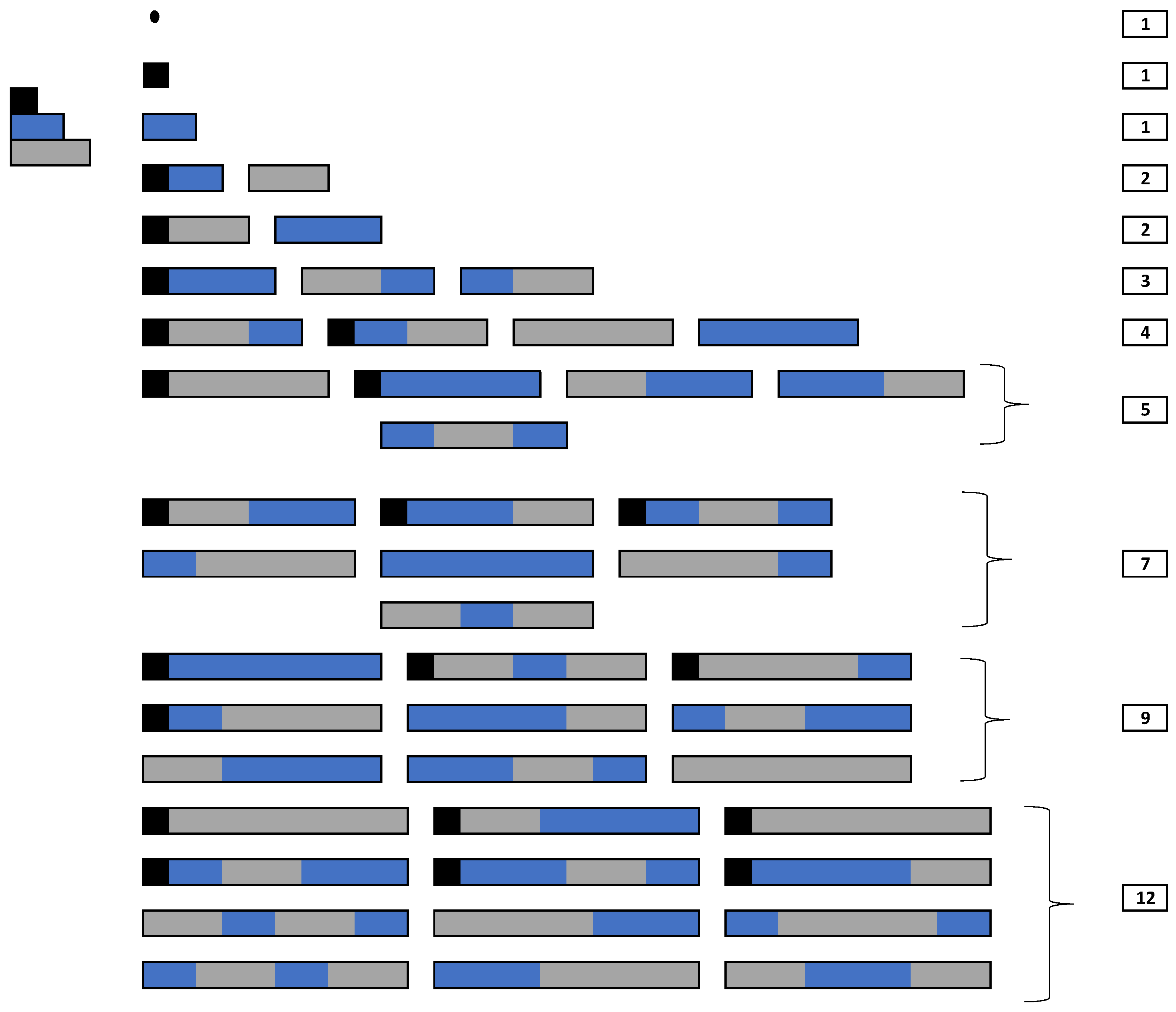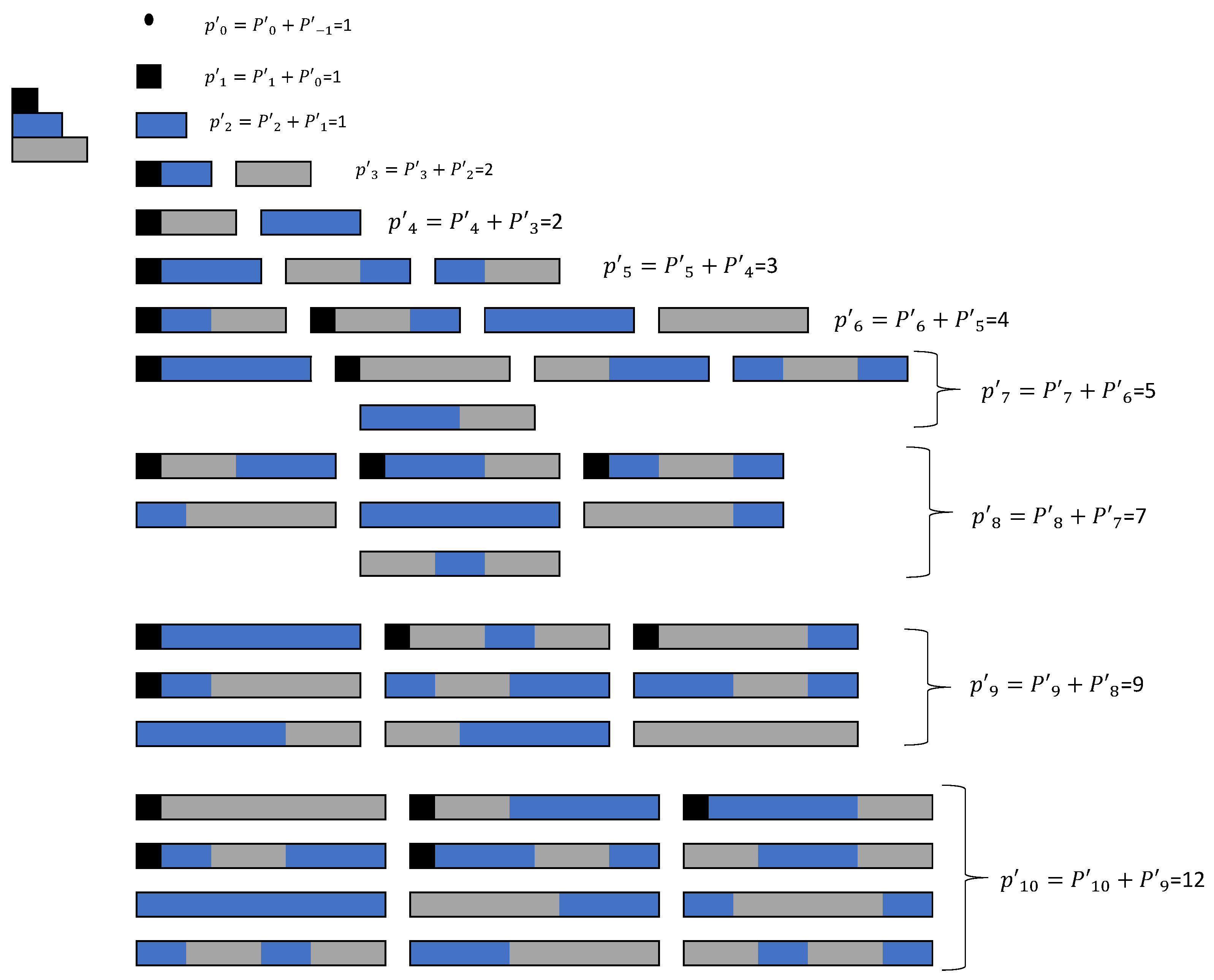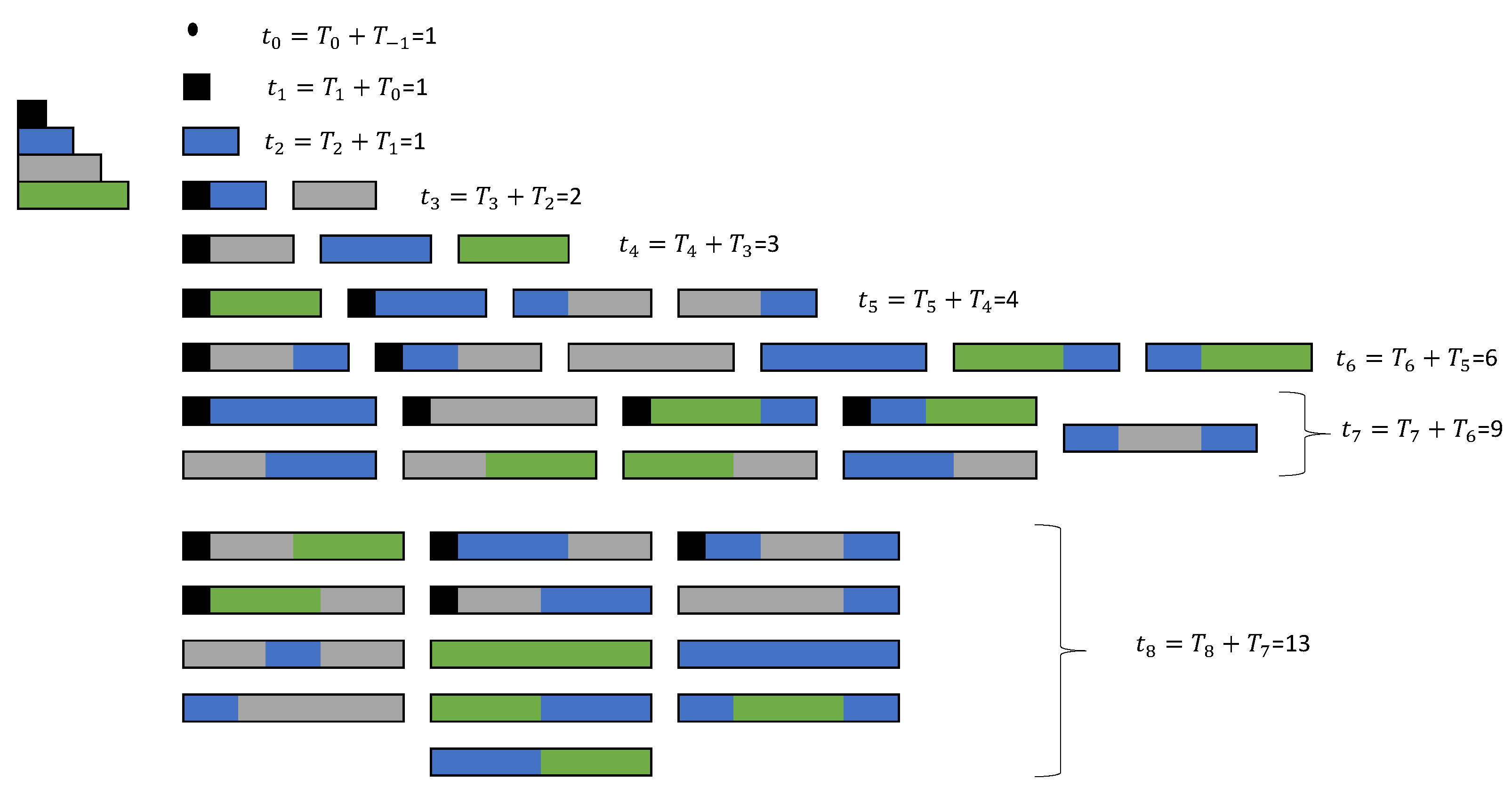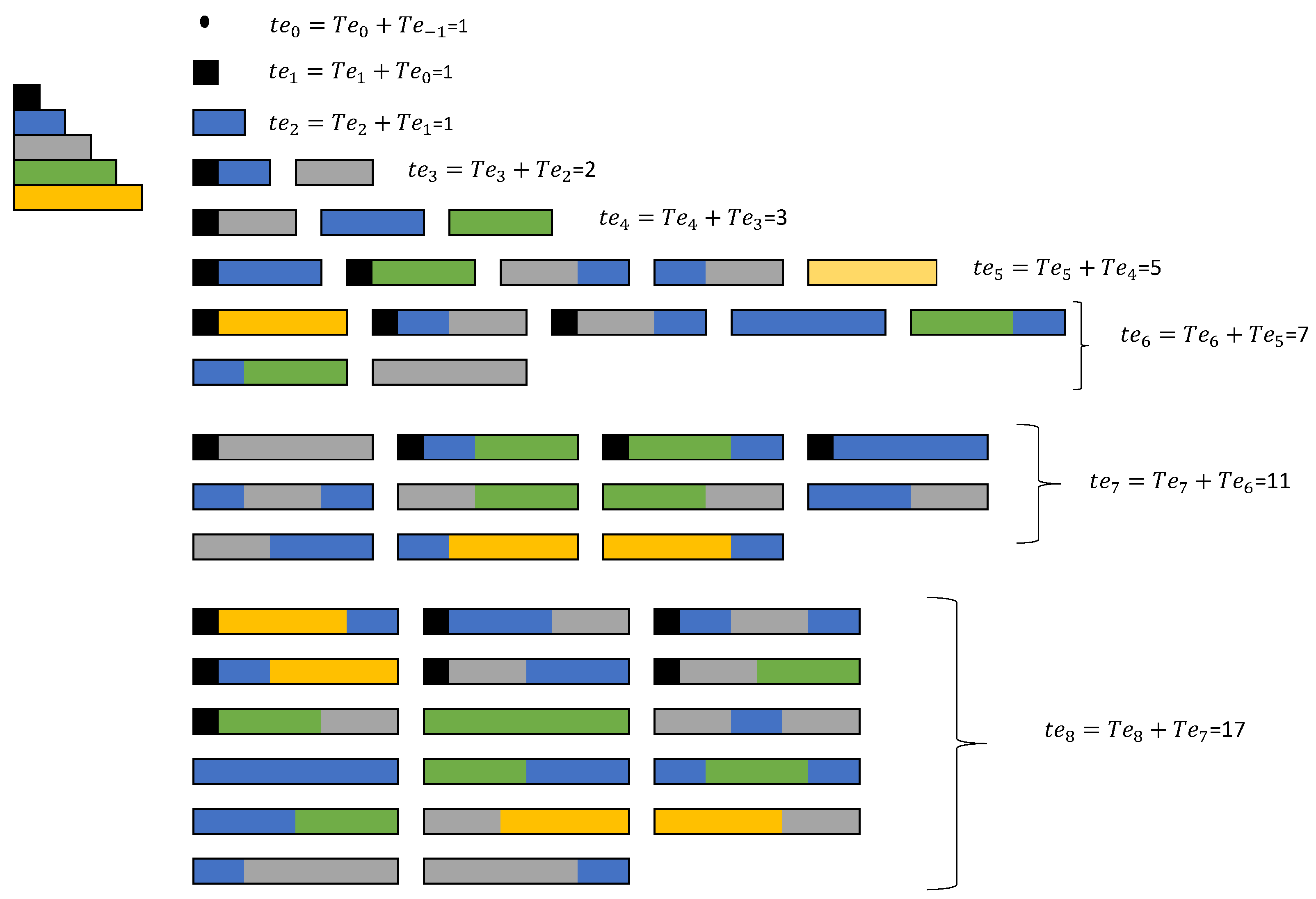2.1. A Combinatorial Model for the Padovan Sequence
Koshy [
13] and Benjamin and Quinn [
12] analyzed the combinatorial behavior of the Fibonacci sequence via tiling. By applying the same idea, we obtained the rules for the construction of a board for the Padovan sequence.
Definition 2. Considering extended domino tiles (defined as rectangles of size 1 × 3: a 1 × 1 black square and a 1 × 2 domino), any board for the Padovan sequence is formed by arranging these defined shapes. The black square is intended to complement the unfilled tiles, subject to the rule of only being inserted at the beginning and only once in each tile. These particular aforementioned rules are defined for the theorem referring to Padovan tiling.
Thus, an
n-board is filled using the following tile shapes: 1 × 1 black squares, 1 × 2 blue dominoes and extended 1 × 3 gray dominoes, all with a weight of 1. In
Figure 2, it is possible to notice that the term
refers to the number of tile shapes in the
n-board; thus, we can determine that
. We can consider
to be fixed since there is no board of size 1 × 0 and
when there is only one black square. Therefore, there is an exception to the rules above since, in this case, the black square is the only shape that is simultaneously at the beginning and at the end.
The number of tiles that start with black squares corresponds to a number in the Padovan sequence, which is given by
. The number of tiles that do not start with black squares is given by
(
Figure 2).
The discussion above gives rise to the following theorem, which relates the elements of the Padovan sequence to the numbers . This theorem was the basis for further combinatorial investigations regarding the Padovan sequence in our study.
Theorem 1. For , the possible tiling of a 1 × n board with black square, blue domino and extended gray domino tiles is given by:where is the number of ways to fill in the 1 × n board and is the n-th term of the Padovan sequence. Proof of Theorem 1.
Let denote the number of tiles in a given board, where and .
Considering an arbitrary set of tiles of size
n (
Figure 1), where
, it can be noticed that the board is formed by the union of two large subsets that are formed of two smaller subsets. These subsets are presented below:
Case 1: Let the two subsets be tiles starting with black squares and the other tiles in a
-board, where the tiles are of size
. Consider a new set of tiles starting with blue dominoes of size 1 × 2, juxtaposed with tiles of size
that do not start with black squares in union with the set of tiles of size 1 × 1 that start with black squares by inserting blue dominoes of size 1 × 2 right after these squares. This union results in a tiling board of size
n (
Figure 3).
Thus, the number of tiles starting with blue dominoes is given by , while the number of tiles starting with black squares followed by blue dominoes is given by . The sum of such tiles is .
Case 2: Let the two subsets be tiles that start with extended dominoes (i.e., tiles that do not start with black squares) and tiles that start with black squares followed by extended dominoes in an
-board, where the tiles are of size
. Consider a new set of tiles starting with extended gray dominoes of size 1 × 3 juxtaposed with tiles of size
that do not start with black squares in union with the subset of tiles of size 1 × 1 that start with black squares by inserting gray extended dominoes of size 1 × 3 just after these squares. This union results in a tiling board of size
n (
Figure 4).
Thus, the number of tiles starting with extended gray dominoes is given by , whereas the number of tiles starting with black squares followed by extended gray dominoes is given by . The sum of such tiles is .
Therefore, , according to the addition principle of the independent analyzed cases, which satisfies the Padovan recurrence (), with the initial conditions of and . Thus, . □
Some Padovan identities are associated with the notion of breaking cells, which was initially introduced by Benjamin and Quinn [
12]. Thus, we have that a tile of size
n is breakable in cell
k if it is possible to decompose the tile into two: One part covering cells 1 to
k and the other covering cells
to
n. On the other hand, the board in cell
k is unbreakable if dominoes occupy cells
k and
or if extended dominoes occupy cells
,
k and
or
and
.
2.2. The Combinatorial Models of Tridovan, Tetradovan and Z-Dovan Sequences
The Padovan sequence was studied by Seenukul et al. [
16], who presented the following initial values:
. It can be noted that the aforementioned work presented a shifted variation of the Padovan sequence, which was primarily introduced by Richard Padovan. Likewise, this work defined a shifted Padovan sequence:
. The first terms of this shifted sequence are described in
Table 1.
Thus, an
n-board was considered with the following tile shapes: 1 × 1 black squares, 1 × 2 blue dominoes and extended 1 × 3 gray dominoes, all with a weight of 1. We emphasize that this rule is introduced and presented in this article for the first time (
Section 2.1). In
Figure 5, it can be seen the term
denotes the number of tile shapes in the
n-board; thus, by following the above rules, it can be determined that
.
Theorem 2. For , the possible tiling of a 1 × n board with black square, blue domino and extended gray domino tiles is given by:where is the number of ways to fill in the 1 × n board and is the n-th term of the shifted Padovan sequence. Proof of Theorem 2.
This theorem can be validated in a similar way to the proof of Theorem 1. □
Next, we explore some of the extensions of the Padovan sequence based on the work of Vieira and Alves [
14] and Vieira et al. [
15], which addressed the definitions of the Tridovan and Tetradovan sequences.
The Tridovan sequence (
) is an extension of the Padovan sequence that is a fourth-order sequence and has a recurrence relation given by
, with the respective initial values of
. The first terms in the Tridovan sequence are shown in
Table 2.
Therefore, following the indications provided by Mehdaoui (2021) [
17], a one-dimensional
n-board was considered and the following tile shapes were considered: 1 × 1 black squares, 1 × 2 blue dominoes, extended 1 × 3 gray dominoes and double 1 × 4 green dominoes, all with a weight of 1. In
Figure 6, it is possible to note that the term
is the number of tile shapes in the
n-board; thus, by following the aforementioned rules, it can be determined that
. Accordingly, we obtained the following theorem.
Theorem 3. For , the possible tiling of a 1 × n board with black square, blue domino, extended gray domino and double green domino tiles is given by:where is the number of ways to fill in the 1 × n board and is the n-th term of the Tridovan sequence. Proof of Theorem 3.
This theorem can be verified in a similar way to the proof of Theorem 1. We leave the details to the reader. □
In
Table 3, we consider the recurrent Tetradovan sequence, as defined in the work of Vieira and Alves [
14] and Vieira et al. [
15], given by
, with the respective initial values of
.
We considered a one-dimensional
n-board and the following tile shapes: 1 × 1 black squares, 1 × 2 blue dominoes, extended 1 × 3 gray dominoes, double 1 × 4 green dominoes and extended double 1 × 5 yellow dominoes, all with a weight of 1. In
Figure 7, it is possible to note that the term
is the number of tile shapes in the
n-board; thus, by following the rules presented in
Section 2.1, we can determine that
. Accordingly, we obtained the following theorem.
Theorem 4. For , the possible tiling of a 1 × n board with black square, blue domino, extended gray domino, double green domino and extended double yellow domino tiles is given by:where is the number of ways to fill in the 1 × n board and is the n-th term of the Tetradovan sequence. Proof of Theorem 4.
This theorem can be verified in a similar way to the proof of Theorem 1. We leave the details to the reader. □
The generalization of the Padovan sequence, called Z-dovan, was studied by Vieira [
5], in which the generalized recurrent sequence was defined as
, where
,
,
and
Z represents the
n-th term of the Z-dovan sequence.
Thus, a one-dimensional
n-board and the following tile shapes were considered: 1 × 1 black squares, 1 × 2 blue dominoes, extended 1 × 3 gray dominoes, double 1 × 4 green dominoes, extended double 1 × 5 yellow dominoes and 1 ×
z orange square, all with a weight of 1. In
Figure 8, it is possible to note that the term
is the number of tile shapes in the
n-board; thus, by following the rules presented in
Section 2.1, we can determine that
. It is noteworthy that the generalized Z-dovan tiling originated from the modified Padovan sequence or considering the original Padovan sequence, the generalization originated from the Tridovan sequence.
Corollary 1. For , the possible tiling of a 1 × n board with 1 × 1 black square, 1 × 2 blue domino, extended 1 × 3 gray domino, double 1 × 4 green domino, extended double 1 × 5 yellow dominoes and 1 × z orange square tiles is given by:where is the number of ways to fill in the 1 × n board and is the n-th term of the Z-dovan sequence. 













